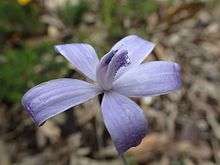Caladenia sericea
| Silky blue orchid | |
|---|---|
 | |
| Caladenia sericea growing in a Perth suburb | |
| Scientific classification | |
| Kingdom: | Plantae |
| Clade: | Angiosperms |
| Clade: | Monocots |
| Order: | Asparagales |
| Family: | Orchidaceae |
| Subfamily: | Orchidoideae |
| Tribe: | Diurideae |
| Genus: | Caladenia |
| Species: | C. sericea |
| Binomial name | |
| Caladenia sericea | |
| Synonyms[1] | |
Caladenia sericea, commonly known as the silky blue orchid, is a plant in the orchid family Orchidaceae and is endemic to the south-west of Western Australia. It is a common orchid in the high rainfall areas of the state and has a single, broad, silky leaf and up to four blue-mauve flowers.
Description
Caladenia sericea is a terrestrial, perennial, deciduous, herb with an underground tuber and a single soft, densely silky leaf, 50–120 mm (2–5 in) long and about 20 mm (0.8 in) wide. Up to four pale blue or mauve flowers 30–50 mm (1–2 in) long and 30–40 mm (1–2 in) wide are borne on a stalk 150–400 mm (6–20 in) tall. The dorsal sepal is erect, 20–30 mm (0.8–1 in) long and 5–8 mm (0.2–0.3 in) wide. The lateral sepals and petals have about the same dimensions as the dorsal sepal. The labellum is 10–15 mm (0.4–0.6 in) long, 7–10 mm (0.3–0.4 in) wide and spotted with purple. The sides of the labellum curve upwards to surround the column, and the short tip curls downward with short teeth on its sides. There are four or six rows of purple calli along the mid-line of the labellum. Flowering occurs from August to early October and is much more prolific after summer fires.[2][3][4]
Taxonomy and naming
Caladenia sericea was first formally described in 1840 by John Lindley and the description was published in A Sketch of the Vegetation of the Swan River Colony.[1] In 2000, Stephen Hopper and Andrew Brown changed the name to Cyanicula sericea,[5] but in 2015, as a result of studies of molecular phylogenetics Mark Clements changed the name back to Caladenia sericea.[6] The specific epithet (sericea) is a Latin word meaning "silken" or "silky"[7] referring to the silky leaf.[3]
Distribution and habitat
Silky blue orchid occurs in the higher rainfall areas of Western Australia between Jurien Bay in the north and Esperance in the east, in the Avon Wheatbelt, Esperance Plains, Jarrah Forest, Swan Coastal Plain and Warren biogeographic regions, growing in forest, woodland and on granite outcrops.[2][3][4][8]
Conservation
Caladenia sericea is classified as "not threatened" by the Western Australian Government Department of Parks and Wildlife.[8]
References
- 1 2 3 "Caladenia sericea". APNI. Retrieved 13 April 2017.
- 1 2 Jones, David L. (2006). A complete guide to native orchids of Australia including the island territories. Frenchs Forest, N.S.W.: New Holland. p. 31. ISBN 1877069124.
- 1 2 3 Brown, Andrew; Dundas, Pat; Dixon, Kingsley; Hopper, Stephen (2008). Orchids of Western Australia. Crawley, Western Australia: University of Western Australia Press. p. 185. ISBN 9780980296457.
- 1 2 Hoffman, Noel; Brown, Andrew (2011). Orchids of South-West Australia (3rd ed.). Gooseberry Hill: Noel Hoffman. p. 193. ISBN 9780646562322.
- ↑ "Cyanicula sericea". APNI. Retrieved 13 April 2017.
- ↑ Clements, Mark A.; Howard, Christopher G.; Miller, Joseph T. (13 April 2015). "Caladenia revisited: Results of molecular phylogenetic analyses of Caladeniinae plastid and nuclear loci". American Journal of Botany. 102 (4): 581–597. doi:10.3732/ajb.1500021. PMID 25878091.
- ↑ Brown, Roland Wilbur (1956). The Composition of Scientific Words. Washington, D.C.: Smithsonian Institution Press. p. 712.
- 1 2 "Cyanicula sericea". FloraBase. Western Australian Government Department of Parks and Wildlife.